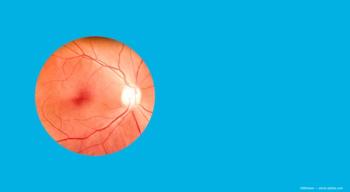
Combo therapy improves VA in AMD patients
Anti-vascular endothelial growth factor (anto-VEGF) monotherapy is inadequate in patients with age-related macular degeneration (AMD). However, by adding an anti-platelet-derived growth factor (anti-PDGF) drug to the anti-VEGF regimen, treatment is enhanced by preventing the development of fibrosis thus improving visual outcomes, according to Usha Chakravarthy, MBBS, PhD.
Belfast, Ireland-Anti-vascular endothelial growth factor (anti-VEGF) monotherapy is inadequate in patients with age-related macular degeneration (AMD). However, by adding an anti-platelet-derived growth factor (anti-PDGF) drug to the anti-VEGF regimen, treatment is enhanced by preventing the development of fibrosis thus improving visual outcomes, according to Usha Chakravarthy, MBBS, PhD.
There are three important aspects of the therapeutic responses observed with anti-VEGF monotherapy for treating neovascular AMD, reported Dr. Chakravarthy, professor of ophthalmology and visual sciences, Royal Victoria Hospital and Queens University of Belfast, Northern Ireland.
“The long-term outcomes with monotherapy are disappointing,” said Dr. Chakravarthy. “The visual acuity changes are not explained by amelioration of exudative manifestations, (and) finally, fibrosis and atrophy are key mediators of the poor outcomes.”
Published evidence has shown a steady decline in vision over time even with persistent anti-VEGF monotherapy.
In the Inhibition of VEGF in the Age-Related Choroidal Neovascularization clinical trial, patient were divided into groups as responders, intermediate responders, and non-responders. When retinal thickness was measured, the visual acuity responses were found to be similar, which indicated that the visual acuity is a poor measure. Further, in the Comparison of Age-Related Macular Degeneration Treatment Trials, fibrosis developed in about 50% of patients.
“For many years, many have recognized that development of atrophy and fibrosis is associated with poor outcomes in patients with AMD,” Dr. Chakravarthy added.
Myofibroblasts are the culprit cells in this process that mediate fibrosis and contraction and they develop from pericytes, macrophases, and epithelial cells when in the presence of PDGF.
“PDGF antagonism prevents migration of these cells and prevents myofibroblasts from laying down fibrosis on their scaffolding,” she explained.
E10030 (Fovista, Ophthotech) is an investigational 50kD DNA aptamer directed against PDGF-B (subunit B). In addition, in an in vivo study, the drug inhibited proliferative vitreoretinopathy and scarring.
“There is evidence of an unmet need with anti-VEGF monotherapy,”she said. “This led to the recent completion of a study of pegpleranib sodium and an anti-VEGF drug compared with anti-VEGF alone.”
In that phase IIb study, 449 patients were randomly assigned to receive one of two doses of pegpleranib sodium (1.5 mg and 0.3 mg) and ranibizumab (Lucentis, Genentech), or to ranibizumab alone (0.5 mg). The primary endpoint was the visual acuity change at 24 weeks. The results showed that the visual acuity levels in the two-pegpleranib sodium groups were superior to those in the ranibizumab monotherapy group.
A subset analysis evaluated patients who lost visual acuity. The analysis showed that the monotherapy arm of the study fared worse than the combination therapy arm. This allows an investigation of how much fibrosis contributes to the macular appearance.
Based on this, the investigators developed a fibrosis, grading scale that ranged from 0 to 4, with 0 indicating no fibrosis and 4 indicating extensive fibrosis. Seventy sets of images were graded at baseline and at 24 weeks. The investigators evaluated the total severity score by study arm, the mean change in fibrosis, the percent of fibrosis at 24 weeks when there was no baseline fibrosis, and at least a 2-step increase in fibrosis.
Dr. Chakravarthy reported that the severity of the fibrosis-i.e., the sum of the absolute grade-was considerably less in the combination therapy arm compared with the monotherapy arm, and the mean severity value of the fibrosis was lower in the combination therapy group compared with the monotherapy arm.
Interestingly, she said, they also found that in patients with no baseline fibrosis, the percentage that developed fibrosis was 5-fold greater in the monotherapy arm compared with the combination therapy arm. Finally, progression of a 2-step scale was double in the monotherapy arm compared with the combination therapy arm.
“Disease modification through the use of an anti-PDGF agent reduces vision loss and fibrous deposition and enhances visual gain,” Dr. Chakravarthy said.
Newsletter
Don’t miss out—get Ophthalmology Times updates on the latest clinical advancements and expert interviews, straight to your inbox.


















































.png)


